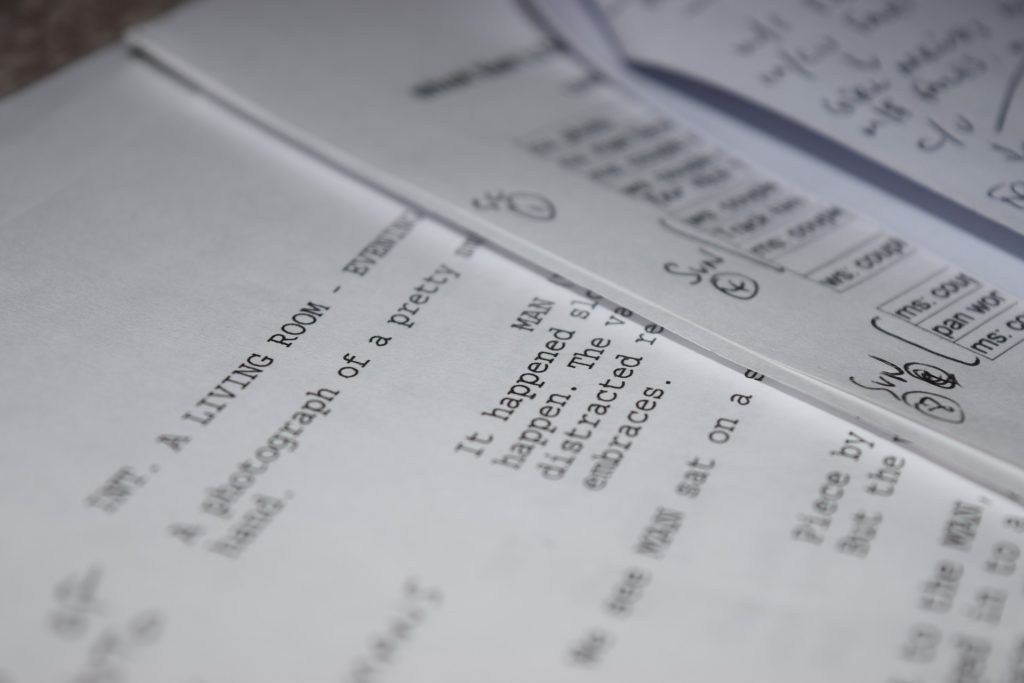
Did you know that multi-camera sitcom formatting is different than a single-camera sitcom?
If not, it’s likely because many writers don’t follow the formatting that is specific to multi-cam, even if that’s what they’re writing. The reason is the style was developed for production and many shows have slight differences from one another.
But if you’re interested in writing for TV, it’s important to know the differences between writing for multicam and single-cam sitcoms, namely the varying formatting rules. Let’s take a look at how each one differs from the other so you can nail your next pilot script.
 Have a Great Pilot? Enter the Launch Pad TV Pilot Screenwriting Competition!
Have a Great Pilot? Enter the Launch Pad TV Pilot Screenwriting Competition!
What Does Multi-Cam Sitcom Format Look Like?
There are a few critical differences between a multi-camera sitcom script format and the rest.
What Gets Underlined?
The first is that certain things get underlined, including:
- The action
- Scene headings
- Names of characters the first time they’re mentioned
What’s Written in All Caps?
The second is that the prose is written in all capitals. These elements allow production to read more quickly the action and find bigger changes, meaning scene changes and character introductions, on the page.
Double-Spacing
Another different element is the dialogue is double-spaced. This causes the page count to double. Where other scripts typically have one page equal to about one minute of screentime, a multi-cam is largely dialogue, so it would usually mean one page equals 45 seconds a page. But because the dialogue is double-spaced, a 22-32 page script quickly winds up closer to 60 pages.
Multi-camera shows are filmed in front of a studio audience and have a faster turnaround from script to production to air. The spacing makes the script easier for production and the cast to read and make notes on when there are last-minute changes.
What Does Single-Camera Sitcom Format Look Like?
Single-camera sitcoms, say…like Ted Lasso, have the same style as traditional screenwriting, with some differences depending on the specific series. For example, network shows include act breaks where the commercials are, while streaming shows mostly leave act breaks out of the script (even if they exist as they’re “breaking” the story in the writers’ room).
You may find single-camera scripts that have similarities with multi-cams, such as underlined scene headers, as you can see here, but these will vary from show to show.
Which Format Should You Use on Your Spec Pilot?
If you are up for a staffing position, this is a conversation that you should have with your representation. The reason is they will know who you’re submitting to and what they prefer to read. But should you write your spec pilot in this format when you’re initially writing drafts? Probably not.
The reason is that these formats exist for production. You want the reader to have zero stumbling blocks from the moment they open your script. Particularly entry-level staff will be assigned a large pile of scripts to get through. You often hear online about readers who stop reading at ten pages because of typos. If a reader does this, they are a bad reader. However, you still don’t want to do anything that makes the reader stumble when they open up your script, and this formatting and the page count that goes with it can have that effect.

If you want to make sure that the reader knows it’s a multi-cam even though you use traditional formatting, simply make sure that you focus the humor on those three central locations that you see in every episode. You can also describe the layout of the sets how they’ll look to the cameras, and you can state it is a multi-camera pilot in your query letter and pitch.
—
There are some pretty glaring differences between script formats, but what stays absolutely the same from one format to another is the shape of the story. There are, of course, lots of theories of how the structure of different formats and genres operate. Ultimately, there is a beginning where something throws the lead character off-balance, followed by a decision of how they’ll deal with the situation; then a middle where that action plays out; and an end where everything climaxes and resolves.
So, as you’re studying this unique formatting, don’t allow it to change how you approach the story, world, and characters other than the number of sets.


